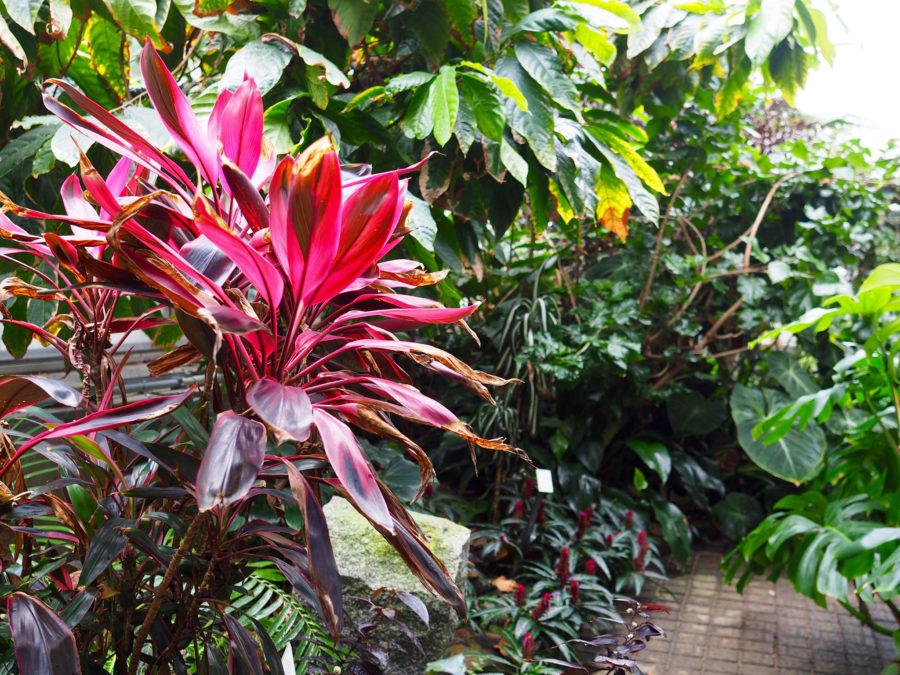Employees of the self-funded greenhouse on campus discuss their struggle to flourish
A varied multitude of greenery can be found at the Conservatory in Urbana, IL. Lily K
Apr 10, 2016
Last updated on Dec. 22, 2016 at 04:10 p.m.
Most weeks, amid the lush leaves of the hibiscus and ficus trees, Emily Davis mkcan be seen sketching the tropical greenery surrounding her, the sound of water trickling in the background as she draws.
“I usually like to sketch the plants — I’m not great at drawing, but practicing in there is fun,” said Davis, sophomore in LAS.
The tropical oasis she retreats to each week isn’t as far as one might imagine it to be. In fact, Davis only needs to walk down the block from her dorm to experience this scenery in one of the Plant Biology greenhousesmk.
“It’s quiet, and my life is really hectic, so I like to go down there to chill for an hour or more … among the plants,” Davis said.
Get The Daily Illini in your inbox!
Davis discovered the greenhouse conservatory during a Biology class and now spends a lot of her free time there.
Though it has been around since the ’90s, the greenhouse is still a pleasant surprise for many. It was built in its current location in 1988 to supplement the plant biology and crop sciences programs. When the programs were more extensive, they relied heavily on the collections for research and teaching classes. However, due to recent cuts to funding, activity has dwindled.
“When we first started, we grew for close to maybe 15 classes, and now we’re down to about four,” said Debbie Black, manager of the conservatorymk.
Black, who has been working for the greenhouse for about 19 years, said this comes as no surprise to her with the state budget cuts in recent years.
She said they used to have eight plant collections, but the greenhouse has reduced this number to about five as a result of the budget cuts.
These cuts in the early 2000s not only caused a decline in production for the greenhouse, but also meant complete eradication of all funds toward it from the University in 2002, according to Black.
“We were classified as expendable,” Black said.
Now, the greenhouse is self-funded and relies on profits from a couple of annual plant sales and private donations. The money fronts the near $15,000 a year that it takes to maintain and care for the conservatory and plant collections.
“It’s a lot of work. People don’t understand you’re in here watering at least an hour a day, and in the summer it may be longer,” she said. “Right there you’re talking seven to ten hours a week, and that’s not even including cleaning.”
Maintenance has been getting tougher, according to Black. She also said that since the horticulture major was eradicated last year, it has been hard to find good help in regards to plant care.
“I used to rely on the students, and when the horticulture department was here, you’d get people that came from the nursery business and landscaping business and had a good basis for student labor, and now that’s gone,” she said.
Black now has four employees who help her care for the plants. Joseph Kincheloemk, one of these employees, explained the extent of care that goes into sustaining the conservatory.
“I’m here on Monday, Wednesday, Friday and sometimes on the weekends watering the aisles; watering in (the conservatory) sometimes; trimming (trees) back; potting stuff up; pricing things for the sale that’s coming up,” he said. “Just cleaning things, maintenance — anything they need me to do, I’ll do it.”
Kincheloe, who recently graduated from Parkland College with an Associate degree in landscape design, has been working for Black since the fall. He said the atmosphere of the job is worth the hard work.
“There’s a nice solitude here,” he said. “You can just get away from things.”
The peacefulness and display of plants loved by many is an important part of the campus, according to Kincheloe and Black. Unfortunately, however, the greenhouse’s future is unclear because of possible upcoming cutbacks.
“With cutting back on how big the collections are and what I bring in from (donations), hopefully it’ll be able to sustain at least the conservatory and a few rooms of collections,” Black said.
Black and her employees are fervent about making the greenhouse work for the sake of others’ enjoyment, though the greenhouse being self-funded leads to uncertainty with the conservatory.
“We try our best,” Black said. “And every little bit helps.”






